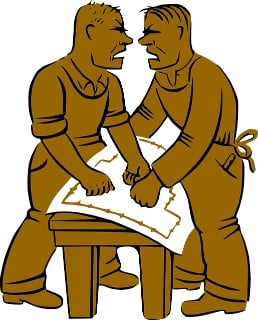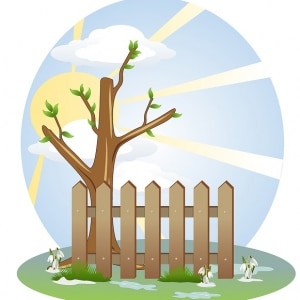Disclaimer:
Perth Arbor Services is not a provider of legal advice or services. The content contained within this article, including any information, commentary, or references, is intended to be used for general informational purposes only. It is not intended as, and should not be perceived as, legal advice or a substitute for such advice.
Most neighbours get along just fine in everyday life, but every now and again, there will be disputes. When it comes to the garden, a common cause for disputes is trees, especially if they begin to encroach on a neighbour’s land. Some neighbours don’t like the idea of tree removal and might be wondering whether legally they need to remove their tree or whether it can be cut back. If you are in a dispute with a neighbour about a tree, here are a few things you’ll need to take into account.
Trees on your land
If you have trees on your land, it’s your responsibility to ensure they don’t cause damage or injuries. This can be from any part of the tree, from the roots below ground to the branches above ground, and is why regular tree maintenance is so essential. It’s easy to see why neighbours can get so upset by trees that are poorly maintained, as they can be both unsightly and potentially damaging. Therefore, if you have a tree with roots that could potentially cause damage, or one that’s hanging over a neighbour’s fence, then the sensible thing to do would be to bring in tree experts so they can work out the best option. This could be cutting the tree back, or removing it completely.
Landowner rights
Australian law states that landowners have the right to enjoy their property. Encroaching trees can cause a number of problems, including:
- Blocking sunlight from the garden or house
- Dropping leaves and debris on neighbour’s gardens
- Blocking TV signals
- Roots growing under neighbouring properties
- Branches falling off in bad weather and causing damage or injury
Under Australian law, if your neighbours tree has the potential to cause damage, poses a hazard to occupants of your home, or interferes with you or your property, you have the right to request that they take action.
Can I cut a neighbour’s tree?
While most neighbours will sort out any tree issues amicably, unfortunately it can sometimes lead to a dispute. In the meantime, you may be stuck with branches overhanging in your garden, which can be annoying. In most states, the law states you are allowed to prune the part of the tree that crosses your boundary line, and this is known as tree abatement. However, it’s important to check local laws, and also make sure there’s no tree preservation order in place.
Tree abatement laws state that the amount of tree you remove shouldn’t be excessive. You should avoid removing more than 10% of the total tree size. Under the law, the tree cuttings and any fruit still belong to the tree owner, so they should be offered back to them. To keep relationships with your neighbour amicable, it’s worth letting them know in advance that you plan to prune the branches, and you may want to bring in tree professionals who can ensure the tree isn’t damaged.
Sometimes it’s difficult to prune a tree without accessing your neighbour’s land. In these cases, you should provide written notice to your neighbour, giving them plenty of notice. Most neighbours will be fine with allowing access, especially if professionals are doing the job, but on occasion, they may refuse, which means you may have to take further action.
What if my neighbour won’t sort out the problem?
If your neighbour doesn’t reply to your letter or refuses to sort out the problem, then the next step could be to contact the Citizens Advice Bureau. In Western Australia, CAB offer mediation services for neighbour disputes, and you can visit them for advice. You provide your neighbour’s name and address, and they’ll invite both parties in for a mediation session, where you both have a chance to put your point of view across. In many cases, this is easier than going to court and could lead to a peaceful resolution.
If mediation is refused, or you can’t reach an agreement, then going to court might be your only option. In the Perth area, disputes about trees are usually handled by the Magistrates Court of Western Australia. Most people get legal advice before they go down this avenue, as it means someone knowledgeable can look over the case, ensuring everything is put together before the case is heard. However, you can file the paperwork by yourself if you prefer.
Taking further action
If you can’t resolve the issue with your neighbour, then you may need to consider further action. You can get court orders in respect of any tree that adjoins your property, with the majority or full tree trunk sitting on the neighbour’s land.
If damaged has been caused, then your first step could be to write to your neighbour. This should include:
- Details of the damaged caused by branches or roots
- Repair quotes – ideally more than one
- A request for your neighbour to pay for the damage
- A request for the tree to be pruned or removed, as appropriate
Your neighbour will then have 21 days to respond to the letter, and will hopefully come back to you with a solution to sort out the problem.
What if my property is rented?
Tenants who are concerned about a neighbour’s tree, or have received complaints about a tree in their garden, should contact their landlord or property management company. It’s important not to prune any tree or make changes to the garden with your landlord’s permission, as this can be in breach of your tenancy agreement.
Trees can cause long disputes between neighbours, but luckily most problems are easy to resolve. Bring in professionals who can carry out lopping, removal, or cutting back of roots. This ensures that the tree can still thrive, and looks good. Most disputes about trees can be sorted out through simple communication and compromise, but if this doesn’t work, then you may need to seek legal advice or take further action.
What Actions Can a Homeowner Take if a Neighbour’s Tree Roots Cause Damage to Their Property?
If a neighbour’s tree roots cause damage to a homeowner’s property in Australia, the homeowner can take the following steps in accordance with the Neighbourhood Disputes (Dividing Fences and Trees) Act 2016:
- Communication: The homeowner should first approach their neighbour to discuss the issue and attempt to reach an amicable resolution. Open and respectful dialogue is encouraged before taking any further action.
- Written notice: If the discussion does not lead to a resolution, the homeowner should provide their neighbour with a written notice detailing the problem, the specific damage caused by the tree roots, and a request for the tree owner to rectify the issue within a reasonable timeframe.
- Expert advice: The homeowner may consider seeking advice from an arborist or other relevant expert to determine the extent of the damage and the best course of action for rectifying it. This information can be shared with the tree owner in an effort to reach a mutually agreeable solution.
- Self-help measures: If the tree owner does not take appropriate action within a reasonable timeframe and the homeowner has the legal right to do so, they may remove the invasive roots themselves or hire a professional to do so. The homeowner should be cautious not to cause significant harm to the tree and may need to bear the cost of this work.
- Dispute resolution: If communication and self-help measures have been unsuccessful in resolving the issue, the homeowner can apply to a relevant tribunal or court for an order to address the problem. The tribunal or court will consider various factors, including the health and safety of the tree, its impact on the environment, and the enjoyment of the property by both neighbours.
It is important to note that the specific rights and responsibilities of homeowners in relation to tree roots may vary depending on the jurisdiction and the provisions of the Neighbourhood Disputes (Dividing Fences and Trees) Act 2016. Therefore, it is advisable to consult with a legal professional to understand the local regulations and procedures in such cases.
What Risks are Associated with Gutters Blocked by Tree Leaves?
There are several risks associated with tree leaves blocking gutters, which can cause problems for both the homeowner and their neighbour. Some of these risks include:
- Water damage: Blocked gutters can prevent rainwater from draining properly, causing it to overflow and potentially leading to water damage to the walls, roof, or foundation of the house.
- Gutter damage: The weight of accumulated leaves and debris in gutters can cause them to sag, bend, or even collapse, resulting in costly repairs or replacement.
- Pest infestations: Blocked gutters can create a damp environment that attracts pests, such as insects and rodents, leading to potential infestations.
- Mould and mildew growth: The accumulation of leaves and moisture in gutters can promote the growth of mould and mildew, which may cause health issues and structural damage to the property.
If you notice that a neighbour’s gutter is full of leaves, consider taking the following steps to address the issue:
- Communication: The homeowner should first approach their neighbour and politely discuss the issue. They can explain the potential risks associated with blocked gutters and offer assistance in clearing them, if appropriate.
- Offer help: If the neighbour is elderly or unable to clean the gutters themselves, the homeowner could offer to help or recommend a professional gutter cleaning service.
- Share information: The homeowner can provide their neighbour with information on the importance of regular gutter maintenance, including the risks of blocked gutters and the benefits of keeping them clear.
- Seek advice: If the neighbour does not take appropriate action and the situation continues to pose a risk to the homeowner’s property, the homeowner may consult with a legal professional or local council for advice on the appropriate course of action.
It is important to maintain a respectful and cooperative approach when discussing such issues with neighbours, as good communication can often lead to a mutually beneficial resolution.


